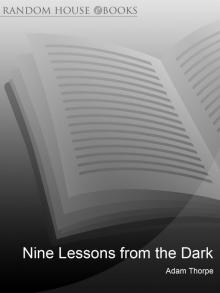- Home
- Adam Thorpe
Hodd Page 31
Hodd Read online
Page 31
73 A culinary technique familiar to the Scots on their campaigns: ‘They nother care for pottis, nor pannis, for they seeth[e] beastis in their own skynnes …’ (Berners’s Froissart, ed. Ellis, 1812, chap. XVII, pp. 18ff.)
74 The term does not exist in Middle English, but has only recently been derived by historians from the medieval Latin, ‘cotarius’ – as used here. The cottar was not a serf but the lowest of the unfree tenants, holding no land on tenure outside his cottage garden and paddock (unlike a villein), and doing day or piece work for others. For a discussion of the worsening of villeins’ rights and freedoms from the late twelfth century in particular, see P. Vinogradoff’s magisterial Villainage in England (Oxford, 1892).
75 Again, ‘other’. The arbitrary spelling of this word seems particularly exaggerated.
76 The notion of a mortal as ‘perfect’ might remind the reader of the Cathari, in the process of being suppressed with the utmost brutality by the French Church at this time: there is, however, little relation between this heresy and Hod’s. The latter is, in fact, far closer to the beliefs of the ‘adepts of the Free Spirit’, whose neo-Platonic, pantheistic, mystical anarchism – possibly inspired by Arabic Sufism – first appears to historians in northern France in about 1200, and spreads throughout Europe, to become (despite intense persecution) the cradle of peasant revolt in the fourteenth century: see A. Jundt, Histoire du panthéisme populaire au Moyen Age et au 16ème siecle (Paris, 1875), and my own Self-Deification: the Doctrine of the Brethren of the Free Spirit (London, 1920).
77 Cf. the entry on satyrs in Bartholomew.
78 Probably the common toadstool Psilocybe semilanceata, known for its intoxicating properties.
79 The sentence is hard to translate, the Latin unusually corrupt: possibly an interpolation.
80 It may be no coincidence that a smooth white neck was traditionally an indication of a lecherous appetite.
81 A mouth pastille to freshen the breath.
82 Compare The Tale of Gamelyn, ll. 593–4: ‘“Nay, by God!” seide thei, “thi drink is not goode, / It wolde make a mannys brayn to lyen on his hode.”’ [Harley MS 7334]. Skeat dates this ballad circa 1340.
83 Iron being associated astrologically with Mars (the count in the author’s dream was called thus), one of whose effects is anger.
84 Dawn.
85 Repetition as in MS: ‘fish fish’. A lost reference.
86 A simile drawn once more from an entry in Bartholomew. The entire passage anticipates the author’s months with the outlaws, rather than obeying the strict narrative progression we would now expect.
87 When synods-men (sidesmen) were required to testify.
88 The text is badly browned from an inserted wheat-stalk pressed between the leaves, no doubt left as a bookmark long ago.
89Cappa, a gown worn by priests and university students.
90 What we are told of this odious parade reminds us of the moralist’s tendency, at any period, to indulge in gruesome, detailed descriptions of the very vices he most disapproves of, thus unconsciously touching on the indecorous or even the obscene.
91 Yew: the favoured wood for the longbow, before ash.
92 The feathers of an arrow.
93 Presumably with the English technique, wherein the body rather than the arm alone is behind the strength of the pulling action.
94 I have pointed out in my little monograph The Early Church (1919) – partly composed during the absolute wet tedium of the trenches – that Christianity was founded on patience, for the imminent end of time promised by Jesus failed to come. As the excommunicated M. Alfred Loisy has famously commented: ‘Jesus preached the Kingdom, and what arrived was the Church.’
95 The tradition that Jesus (rather than Satan or Judas) had red hair is still alive in our rustic village, where the presently bearded translator is known as ‘Walking Jesus’ by the local children.
96 Elderberry.
97 The matter within the parentheses is to be found crammed into the margins of the leaf, in a similar if rougher hand: a rare example in this document of an insertion, which suggests an oversight by the copyist, or the weary copyist’s own heartfelt intrusion.
98 Founded in 656, an early seat of great learning. It might not be too fanciful to associate the present-day Robin Hood’s Bay, lying between Whitby and Scarborough, with the locale of the hermitage, for reasons the denouement of this narrative will make clear. The cliffs are backed by moorland remarkable for its exposure and lack of habitations.
99 About 1215; the northern barons were well represented at the meeting at Runnymede in 1216, that led to Magna Carta.
100 At an estimated rate (for oxen) of less than an acre a day, theoretically measured in strips 22 yards wide and 220 yards long (viz. a furlong). Medieval farming was crude and exhausting, lacking any incentive to improve itself, though fundamentally the same as that of the present day.
101 Meaning either ‘soft’ or ‘moist’, this is a word that seems to me in need of rehabilitation.
102 The death rate among children was, of course, very high: it has been estimated that well over a third did not survive beyond the age of nine.
103 Finland.
104 The Latin is very corrupt, but the sense clear.
105 The swift (not formerly distinguished, at least linguistically, from the swallow).
106 I have considerably abbreviated these reflections.
107 This rant is not to be confused with the latent ‘Internationalism’ of a Wat Tyler, or of the later and thoroughly romanticised figure of Robin Hood.
108 As in MS: ‘lyte’ meaning little. The earliest known reference to Robin’s most famous companion.
109 The text is somewhat corrupt here, or at least confused, but the general sense is plain.
110 As noted above, Hod’s rantings are so similar to the beliefs of the Brethren of the Free Spirit, first identifiable in France and along the Rhine at around the time of our present narrative (1220s), that one wonders whether his late travels upon the Continent had not infected him with what are strikingly ‘foreign’ heresies. Alternatively, it is possible that our author has sought to fit Hod’s somewhat contradictory beliefs into that particular hole – rounded them off, as it were – in order the better to condemn a movement that, by the date of our document (c.1305), had become alarmingly active again.
111 During the late world deluge, in a well-known Belgian city, a wooden fence was built around three streets given over to military brothels, in order to hide the long queues of waiting servicemen from passers-by.
112 The insistence on this peculiar contradiction in Hod’s character seems to weaken the argument for a worked-up, authorial charge of heresy, since heretics were frequently associated with such carnal and ‘unnatural’ impulses – and specifically the type delineated here, resulting in several lines being piously erased. This particular impulse was, however, a familiar one to medieval commentators on monastic discipline, including Augustine.
113 The text has the nonsensical fulmino (‘to thunder and lighten’), probably the distracted copyist’s misreading.
114 A modern theory that ‘lepra’ was a form of syphilis might be noted here (though syphilis in its current form is said to be unknown before the New World discoveries of the fifteenth century). More relevant is the generalised aura of sexual guilt that surrounded the medieval leper, who was thought to be the result of parental incontinency.
115 Such houses of pleasure were a most common appurtenance in medieval towns and cities, especially following the Gregorian reforms concerning marriage. Again, a pious successor to the copyist has seen fit to erase this extraordinary passage, but not sufficiently, the ink still being dimly visible on the vellum in most parts: consequent elisions are indicated.
116 Or possibly ‘touching’, or ‘defiling’, or ‘sprinkling’, among other less likely meanings.
117 Glasswort (marsh samphire).
118 This was the standard method in schools, which from about
this period became far more numerous, though still affordable only by a minority. It was not unknown, however, for ambitious peasants to send their sons to school in the local town. The picture is very unclear due to scanty records, and requires far more research.
119 Probably not very different in style from the broad-brimmed, felt type we still see in use in our modern fields.
120 The outlaws’ huts seem more sophisticated than in the romanticised legend where damp and chill winds do not exist; and furthermore provide interesting textual clues to the construction of simple medieval dwellings of the sort that have left no trace, bar their ‘post-holes’.
121 See my note above on the Free Spirit heresy, which this passage almost too smoothly echoes.
122 This suggests, not that the author has moved to a Carthusian monastery – where a strict vow of silence prevails – but that age has rendered him deaf.
123 The ordeal by fire, officially abolished as a test of guilt or innocence in 1218.
124 I have proposed the Middle English term for chirurgus (a surgeon).
125 This being either the Latin version of the Qur’an by Robert of Ketton (1143), Lex Mahumet pseudoprophete, or the more literal translation of Mark of Toledo. The relevant passage is probably the following: ‘I will cast terror into the hearts of those who disbelieve; smite ye above their necks and strike off all their fingertips.’ (chap. viii, 12).
126 Scotland.
127 At no point is he ever certain of his age, and (typically for a medieval author) tends to telescope narrative incident.
128 Spitting on the ground was so common in the Middle Ages as to be not necessarily insulting, and our own awareness of pulmonary or tubercular infection is modern.
129 A blacksmith’s apron (lit. ‘bosom-skin’). See the contemporary Arundel MS, 292, f. 72.
130 This somewhat peculiar simile is, in fact, borrowed directly from Abelard’s famous account of his own life (he died in 1142).
131 This being a peculiar habit of Fritz’s early in the war, who left even schools and furnished houses similarly smeared with excrement.
132 Presumably St Odo of Cluny’s De vita sancti Gerardi. St Gerald of Aurillac died in 909.
133 Possibly ‘manly’ or ‘virile’.
134 As in MS: ‘of one essence’, ‘consubstantial’. The Creed was established at the Council of Nicaea in 325, which wrestled with the relationship between Father and Son, and with the question of Christ’s divinity; finally incorporating the Greek word homousios, thus allowing the Son to be both human and divine – a crucial doctrinal development, nevertheless disputed by those who said that the word, not appearing in the fonts of revelation, was illegitimate.
135 i.e. a harelip, sometimes surgically dealt with even then, though at huge risk to the patient.
136 Which interestingly remains concealed throughout the narrative.
137 Butts: being a range for archery practice.
138 The usual medieval colouring aside, this is quite a reasonable description of what happens scientifically, in terms of the translation of kinetic energy, when an arrow is shot.
139Virga meaning a ‘thin green twig’, I have assumed the Middle English ‘prikke’: a thin branch cut from shrubs and set vertically as a target (cf. Robin Hood and Guy of Gisborne, stanza 28).
140 As in MS: readers may recognise the ‘Will Scarlock’ of A Gest of Robyn Hode, which Mr W. H. Clawson has lately dated to c. 1400.
141 Cuckoo.
142 No doubt this was not a precious book, but the product of an ordinary scrivener: the invaluable Mr G. G. Coulton calculates the average copyist’s rate later in this century to be about 3,300 words a day, paid at an artisan’s rate of 6d a week with board and lodging (Social Life in Britain from the Conquest to the Reformation, Cambridge 1918, p. 102).
143 Such signalling could be very useful: after an impromptu night raid on the German trenches had left me the sole survivor in a party of five, I was guided back to our lines by the flashing of three orilux lamps, despite the enemy flashing theirs to confuse me, and keeping up a lively fire.
144 ‘From great adventures.’
145 ‘Great? No, little, for this fellow (rascal?) be small to look at.’ It is possible that the copyist is French-speaking and, unfamiliar with the English, has written the nonsensical ‘fefalwe’.
146 The bewildering variants in the spelling of much as both adjective and name are faithful to the text, and equally present over a century and a half later in the written Hood ballads, where ‘Much the little minstrel seen’ has become, through what seems to be a natural distortion of eye or ear, ‘Much the miller’s son’ (‘Moche the mylner sun’). In the same way, the here-mentioned Will Scarlack, Scathelock, etc., eventually became Will Scarlett: these two being among the very few named outlaws (along with Little John and Robin) at that ‘primitive’ stage of the legend (c. 1450).
147 The earliest known reference to, as well as explanation of, the outlaw’s more famous appellation.
148 Cancer.
149 Adam’s apple.
150 The clarity of the Latin suffers here from several verbal contractions (e.g. ex for exitus and effr for effringere), but the general sense is plain.
151 Exodus 20.5: I have adapted the translation from the Wycliffite Bible (Bod. 959), c.1382.
152 The cormorant.
153 A further borrowing from Bartholomew, though the original observation is Pliny’s.
154 2 February.
155 In other words, as the man playing the front half of the hobby horse.
156 i.e. mandibles.
157 This was no doubt an ordinary eagle’s head or other bird of prey; the claws unlikely to have been a lion’s. The medieval bestiary included many ‘marvels’ (mirabilia), that were a vestige of the folk or mythical tradition and reluctantly tolerated by the Church – whereas anything designated ‘magical’ was thoroughly condemned.
158 The medieval fondness for both lists and minute detail is here perfectly illustrated. [Additional note in margin in FB’s hand: ‘Inherited by the military’.]
159 Cf. the following: ‘In the middle of the eye … is a certain humour most pure and clear. The philosophers call it crystalloid, for it taketh suddenly divers forms and shapes as crystal doth.’ (Trevisa’s Bartholomew, Libra III, cap. xvii.)
160 Although juvenis in classical times referred to men or women between twenty and forty.
161 i.e. to Palestine.
162 Presumably at the Straits of Gibraltar.
163 A looking glass (for it ‘shews’; a ‘mirror’ is so called only when curved).
164 This familiar situation was later to be addressed by Chaucer in ‘The Merchant’s Tale’.
165 It seems odd (at least to our modern sensibilities) that this frank account should have been related to a young boy, who when he finally left the hermit was still only nine or ten.
166 St Ives in Cornwall.
167 Literally begging rather than as a friar seeking alms, as the Dominicans only came to England in 1221.
168 Spent with wandering.
169 It is unclear whether this is the same ‘rouncy’ that has just been referred to.
170 Cf. Chaucer’s ‘the scornynge jay’ in The Parliament of Fowls, l. 346.
171 A war horse, the highest class of mount. £40 sterling is the equivalent of about £700 in our own day (1921).
172 See my previous note on the local topography. Both ‘Salise’ (Sayles) and Watling Street are mentioned in A Gest of Robyn Hode (as, of course, are Much and ‘Will Scarlock’).
173 This would also, presumably, have made their unseating easier, and rendered them less in control of their mounts.
174 Recognised by Roger Bacon in the thirteenth century as one of the five essential colours.
175 Such horrors were vouchsafed by the general violence of the age, when even the law in most countries practised torture and prolonged execution; two of the acts cited occur in the Old French thirteenth-century romance Eustace t
he Monk (Wistasse li Moine, Bibl. Nat., 1553, fols 325v–338v.). The whole passage is an interesting indication of the impunity with which powerful bandits acted in a period with no proper police force, and in which the law itself was swayed by vested local interests.
176 ‘A band usually of linen which covered the neck, and was drawn up over the chin, strained up each side of the face, and generally fastened across the forehead.’ (W. W. Skeat, The Student’s Chaucer, 1897, p. 125.)
177 Thirteenth-century sleeves were usually buttoned tight from elbow to wrist.
178 I witnessed the same strange phenomenon, whereby perfectly decent men can become cruel or even savage in their obedience to higher authority, in the miserable conditions of the late war.
179 An abuse punishable, according to canon law (even within marriage), by ten days fasting on bread and water (see, for example, the eleventh-century Decretum of Burchard of Worms).
180 An obscure reference to the common use by medieval doctors of startlingly pagan incantations when administering medicines. See my entry ‘Leechcraft and the Great Mother’, in A History of Medicine, 1913, vol. 1, p. 217.
181 As in MS: a standard medieval measurement of time, in which time and space are mingled. A ‘mileway’ is twenty minutes – the time it takes to walk a mile. ‘Half a mileway’ is therefore ten minutes.
182 A common, strong-smelling salve for wounds.
183 So similar is this in word and content to an anecdote in the thirteenth-century Preacher’s Manual of Etienne de Bourbon (Anecdotes Historiques, etc., d’Etienne de Bourbon, ed. A. Lecoy de la Marche, 1877, p. 198), that one assumes the book was familiar to the author.
184 The words judiciously obscured by a stain.
185 Only the finer houses used metal vessels, which were otherwise of wood or pottery; the wooden bowls (judging from the extremely rare survivals) most beautifully fashioned.

 Missing Fay
Missing Fay Hodd
Hodd Pieces of Light
Pieces of Light The Standing Pool
The Standing Pool Ulverton
Ulverton Nine Lessons From the Dark
Nine Lessons From the Dark Flight
Flight The Rules of Perspective
The Rules of Perspective From the Neanderthal
From the Neanderthal Is This the Way You Said?
Is This the Way You Said? Still
Still No Telling
No Telling Voluntary
Voluntary Between Each Breath
Between Each Breath